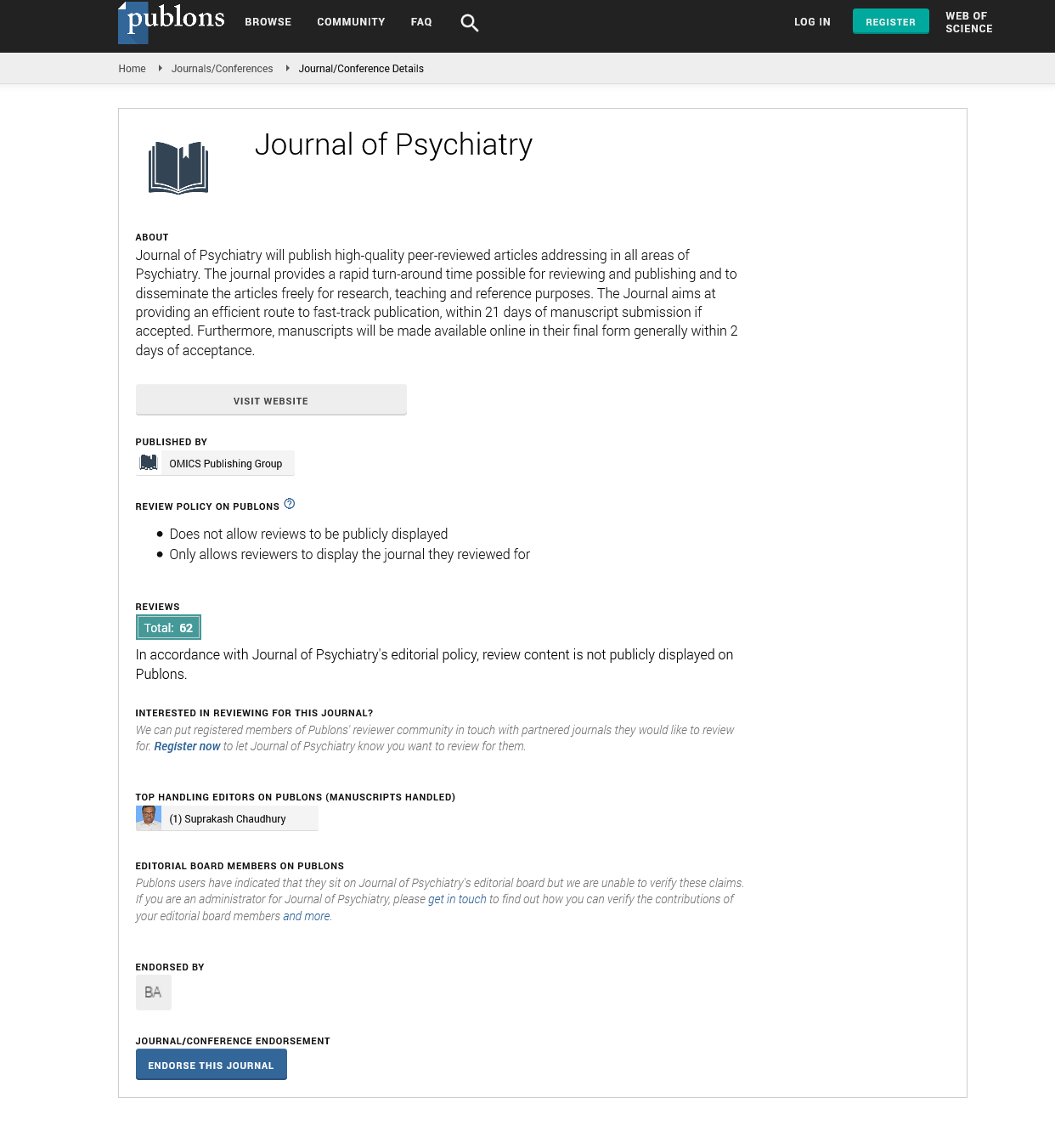Indexed In
- RefSeek
- Hamdard University
- EBSCO A-Z
- OCLC- WorldCat
- SWB online catalog
- Publons
- International committee of medical journals editors (ICMJE)
- Geneva Foundation for Medical Education and Research
Useful Links
Share This Page
Open Access Journals
- Agri and Aquaculture
- Biochemistry
- Bioinformatics & Systems Biology
- Business & Management
- Chemistry
- Clinical Sciences
- Engineering
- Food & Nutrition
- General Science
- Genetics & Molecular Biology
- Immunology & Microbiology
- Medical Sciences
- Neuroscience & Psychology
- Nursing & Health Care
- Pharmaceutical Sciences
Commentary - (2024) Volume 27, Issue 6
Oxidative Stress Biomarkers in Schizophrenia and Psychotic Disorders
Roza Tussupova*Received: 30-Oct-2024, Manuscript No. JOP-24-27750; Editor assigned: 01-Nov-2024, Pre QC No. JOP-24-27750; Reviewed: 15-Nov-2024, QC No. JOP-24-27750; Revised: 21-Nov-2024, Manuscript No. JOP-24-27750; Published: 29-Nov-2024, DOI: 10.35248/2167-0358.24.27.718
Description
Schizophrenia and related psychotic disorders are complex mental illnesses characterized by a combination of positive symptoms (hallucinations and delusions), negative symptoms (apathy and social withdrawal) and cognitive impairments. Despite significant advances in understanding the neurobiological underpinnings of these disorders, their exact etiology remains elusive. Emerging evidence suggests that oxidative stressa state of imbalance between the production of Reactive Oxygen Species (ROS) and the body's antioxidant defenses plays a critical role in the pathophysiology of psychotic disorders. Oxidative stress biomarkers have thus gained attention as potential tools for understanding disease mechanisms, assessing disease progression and developing targeted therapeutic strategies.
Oxidative stress results from the excessive accumulation of ROS and Reactive Nitrogen Species (RNS), which are highly reactive molecules produced as byproducts of normal cellular metabolism. Under physiological conditions, ROS and RNS are regulated by endogenous antioxidant systems, including enzymatic defenses such as superoxide dismutase, catalase and glutathione peroxidase, as well as non-enzymatic molecules like glutathione and vitamins C and E. However, in schizophrenia and psychotic disorders, this balance is often disrupted, leading to cellular damage, mitochondrial dysfunction and impaired synaptic signaling. These effects are particularly evident in brain regions involved in cognition, emotion and sensory processing, such as the prefrontal cortex, hippocampus and thalamus.
One of the most extensively studied oxidative stress biomarkers in schizophrenia is malondialdehyde, a product of lipid peroxidation. Elevated MDA levels have been consistently observed in the plasma and cerebrospinal fluid of individuals with schizophrenia, suggesting increased oxidative damage to cell membranes. Similarly, markers of protein oxidation, such as carbonylated proteins and DNA oxidation, including 8- Hydroxy-2'-Deoxyguanosine (8-OHdG), are significantly elevated in patients with psychotic disorders. These findings highlight the pervasive nature of oxidative damage across multiple cellular components.
Glutathione, the brain’s most abundant antioxidant, has emerged as a key biomarker in schizophrenia research. Reduced levels of Glutathione (GSH) in the prefrontal cortex and striatum have been linked to cognitive impairments and negative symptoms in schizophrenia. The enzymes involved in GSH synthesis, such as glutamate-cysteine ligase and glutathione synthetase, are also dysregulated in patients, further compounding the antioxidant deficit. Genetic studies have identified polymorphisms in genes related to GSH metabolism, such as Glutamate-Cysteine Ligase Catalytic Subunit (GCLC) and GSS, as potential risk factors for schizophrenia, underscoring the role of oxidative stress in the disorder’s genetic architecture.
Another significant finding is the interplay between oxidative stress and mitochondrial dysfunction. Mitochondria are the primary source of ROS production during cellular respiration and their dysfunction exacerbates oxidative stress, creating a selfreinforcing cycle. In schizophrenia, mitochondrial abnormalities, including altered electron transport chain activity and reduced mitochondrial DNA copy numbers, have been observed. These changes contribute to impaired energy metabolism, synaptic dysfunction and neuronal atrophy, which are central to the progression of psychotic disorders.
Inflammation and oxidative stress are closely interconnected, forming a vicious cycle that amplifies neuronal damage in schizophrenia. Pro-inflammatory cytokines, such as Interleukin-6 (IL-6) and Tumor Necrosis Factor-alpha (TNF-α), can induce oxidative stress by activating microglia and increasing ROS production. Conversely, oxidative stress can enhance the production of pro-inflammatory mediators, perpetuating a chronic neuroinflammatory state. This interaction suggests that targeting oxidative stress could have downstream effects on reducing inflammation and vice versa, providing a dual therapeutic benefit.
The clinical implications of oxidative stress biomarkers in schizophrenia are profound. First, they offer a potential avenue for early detection and risk stratification. Studies have shown that individuals at ultra-high risk for psychosis exhibit elevated oxidative stress markers even before the onset of full-blown psychosis, indicating their potential utility as predictive biomarkers. Second, they provide insights into disease heterogeneity, as oxidative stress levels correlate with specific symptom domains, such as cognitive deficits and negative symptoms. This correlation could facilitate the development of personalized treatment approaches based on oxidative stress profiles.
Therapeutically, antioxidants have shown promise as adjunctive treatments for schizophrenia and psychotic disorders. Compounds such as N-acetylcysteine, which replenishes GSH levels and omega-3 fatty acids, which reduce lipid peroxidation, have demonstrated efficacy in alleviating symptoms and improving functional outcomes in clinical trials. Other emerging therapies include coenzyme Q10, vitamin E and alpha-lipoic acid, which target different aspects of oxidative stress. However, challenges remain in translating these findings into routine clinical practice, including variability in treatment responses and the need for optimized dosing strategies.
Despite the growing evidence, several questions remain unanswered. The causal relationship between oxidative stress and schizophrenia is still debated, with some researchers arguing that oxidative stress is a consequence rather than a driver of the disorder. Additionally, the heterogeneity of psychotic disorders complicates the identification of universal oxidative stress biomarkers. Future research should focus on longitudinal studies to establish causality, explore sex differences in oxidative stress responses and investigate the potential of multi-omics approaches to integrate oxidative, inflammatory and genetic data.
Citation: Tussupova R (2024). Oxidative Stress Biomarkers in Schizophrenia and Psychotic Disorders. J Psychiatry. 27:718.
Copyright: © 2024 Tussupova R. This is an open-access article distributed under the terms of the Creative Commons Attribution License, which permits unrestricted use, distribution and reproduction in any medium, provided the original author and source are credited.

